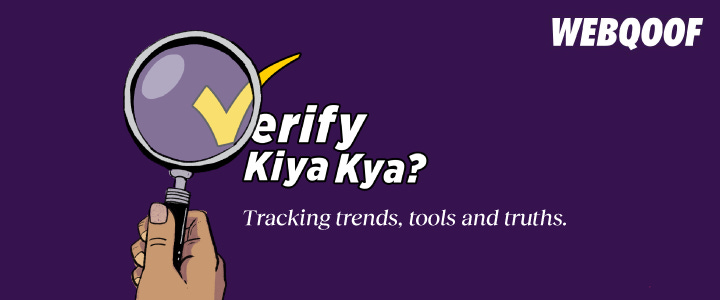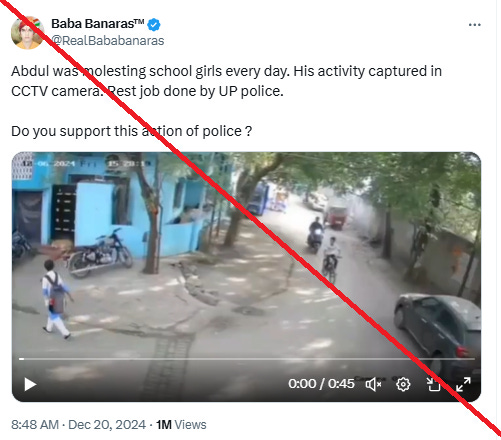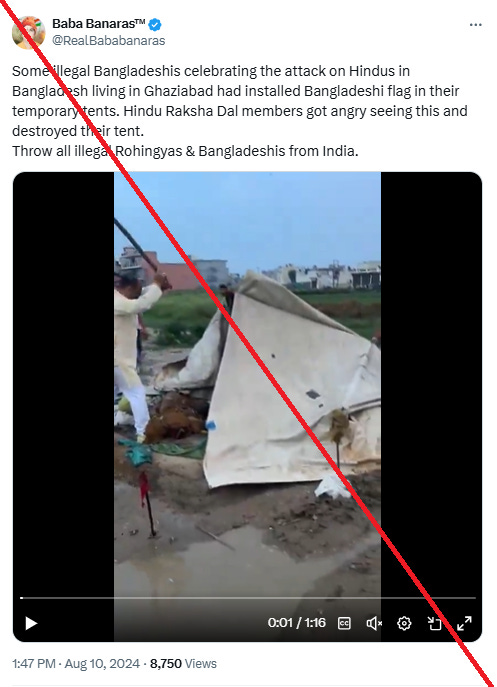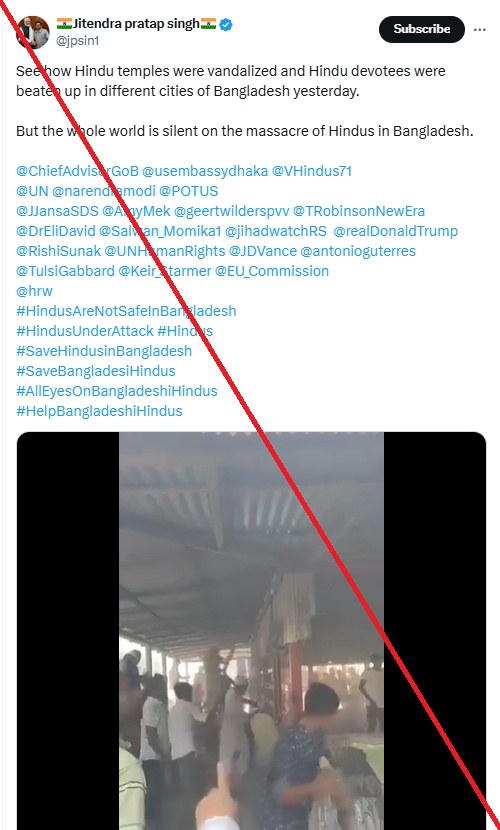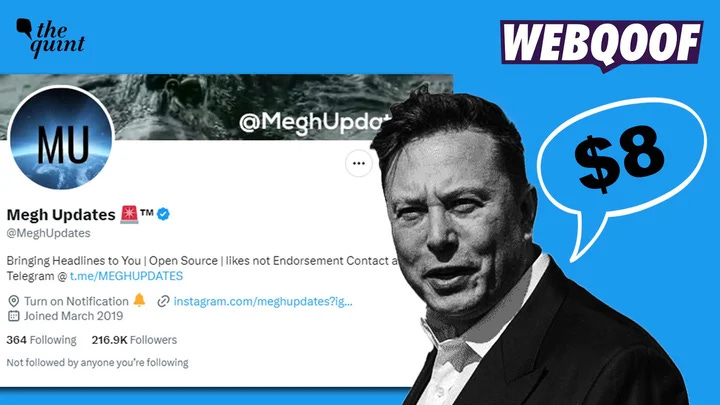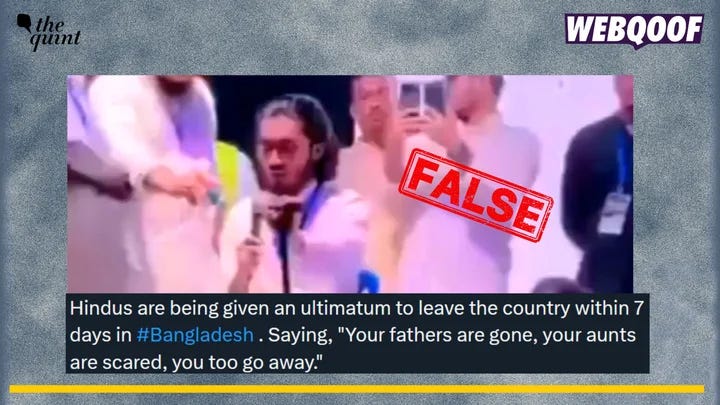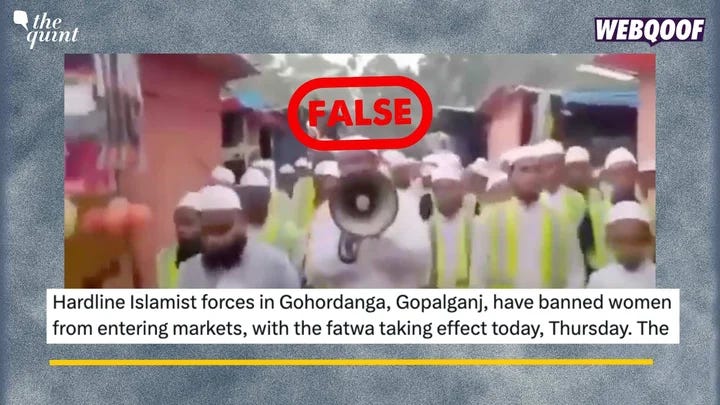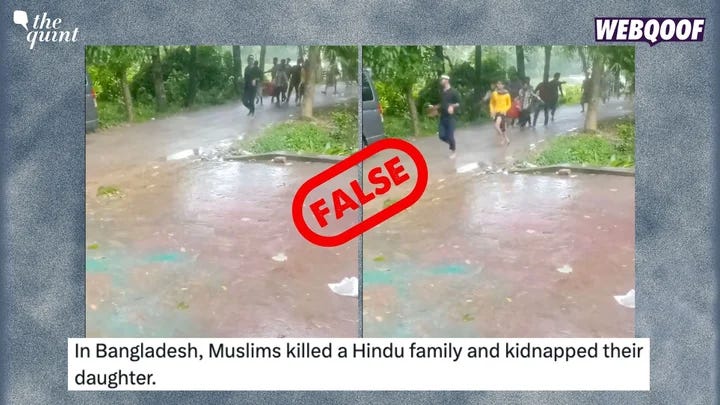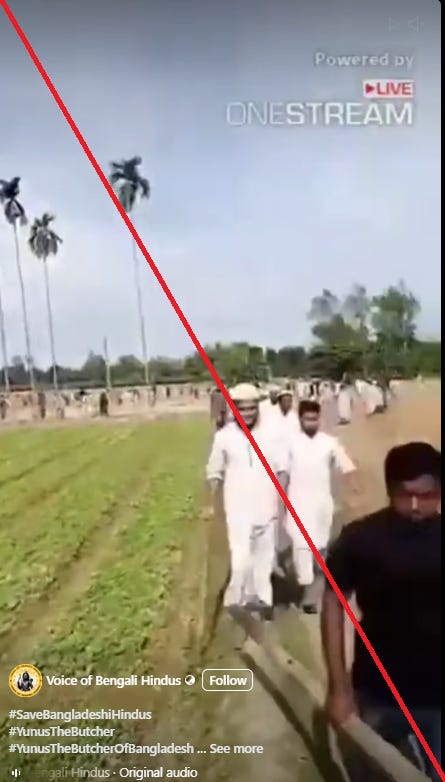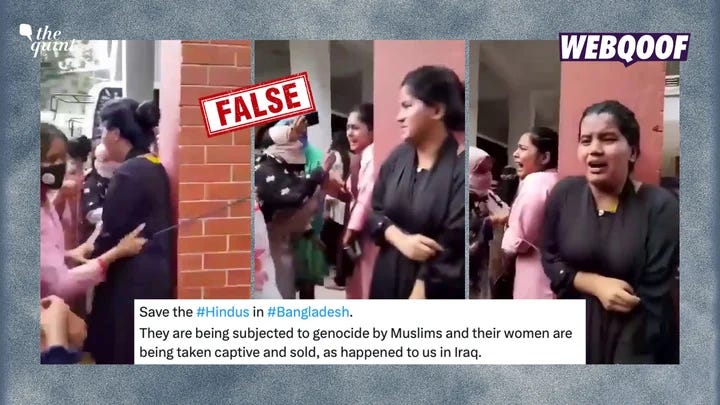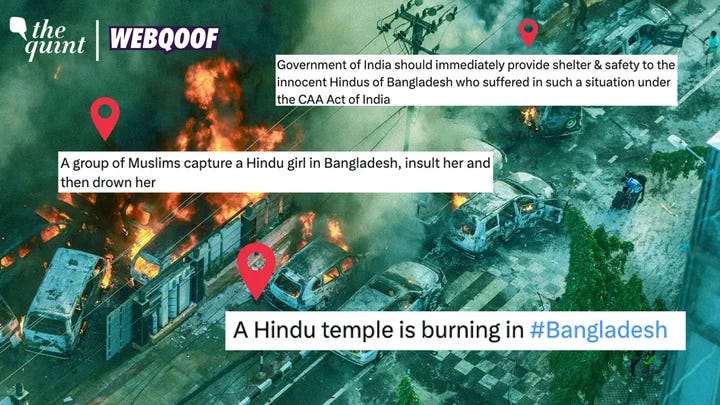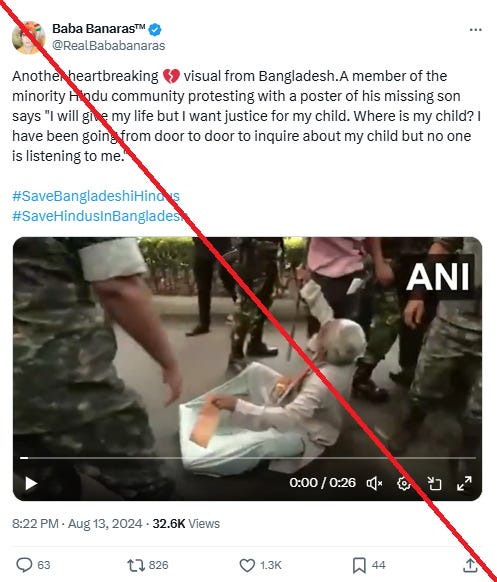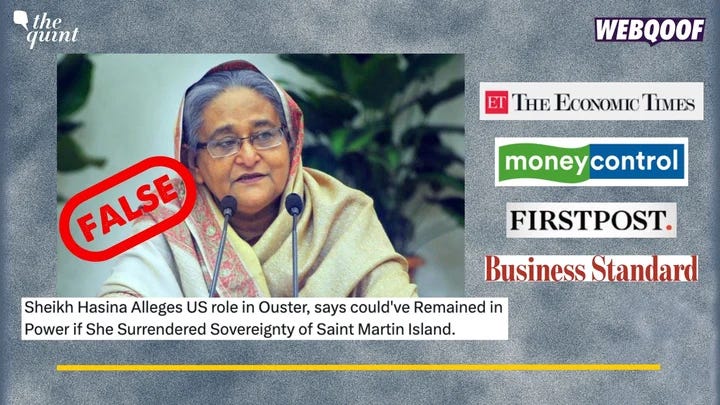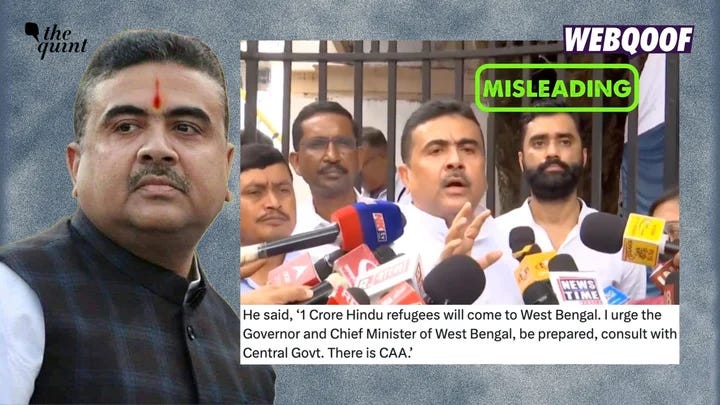Unmasking Indian Bad Actors Spreading Bangladesh-Related 'Fake News'
WebQoof, which has been working to debunk misnformation from Bangladesh, has published at least 70 fact-checks since August.
Dear Reader,
(TRIGGER WARNING: Some visuals may be disturbing.)
An analysis by Bangladeshi fact-checking organisation, Rumor Scanner, found that “72% of the accounts spreading… misinformation” on the current political turmoil in Bangladesh “are located in India”.
The Quint’s WebQoof, which also has been working to debunk mis and disinformation from Bangladesh, has published at least 70 fact-checks since August. In our work, we were able to identify six unique X accounts — all subscribers of X Premium, and some with millions of followers — which routinely spread harmful narratives and misinformation related to Bangladesh.
It was not just X. Facebook and YouTube users as well as certain Hindi and English media organisations are responsible for spreading disinformation on the ongoing crisis. In this month’s analysis, we unmask the modus operandi of those social media users and media organisations.
The Big Players
The most prominent account we came across was ‘@RealBabaBanaras’, 14 of whose posts The Quint has debunked. These posts carrying misinformation saw massive engagement, cumulatively amassing over six lakh views and shared by more than 10,000 users.
The first viral piece of misinformation this account shared was related to Bangladeshi cricketer Liton Das. At the beginning of the political unrest, ‘@RealBababanaras’ had shared a video of a house on fire alongside Das’ photo, claiming that he had been attacked due to his Hindu identity.
It also saw high engagement on false claims about Hindu places of worship being targeted by the Muslim community in Bangladesh.
The account has nearly 70,000 followers and got ‘verified’ in September 2024, weeks after its misinformation about Das’ house went viral. It is worth noting that X’s new ‘verification’ system allows people subscribing to the platform’s ‘premium’ verification to make money off their posts, which increases when the account sees high engagement.
Apart from using misleading visuals to claim that Hindus are constantly under attack in Bangladesh, the account also shares posts vilifying the Muslim community in India and promoting pro-Hindutva content.
A strong example of this is two posts that this account shared, showing right-wing organisation Hindu Raksha Dal’s Pinky Chaudhary attacking and demolishing a shanty in Ghaziabad, accusing its residents of being ‘Bangladeshi infiltrators’.
Team WebQoof went on the ground to find out the truth behind this violent act and viral claim only to find that the people had simply come to Ghaziabad from Uttar Pradesh’s Saharanpur, looking for work.
You can watch this episode of our series on the real impact of fake news here.
Indian Muslims Labelled 'Bangladeshi Infiltrators', Attacked in Ghaziabad Slum |The Quint Fact-Check
One of the claims about Hindu places of worship being attacked was shared by several other X accounts. Sharing a video of a shrine of a Sufi saint being demolished in Bangladesh, the account falsely claimed that it showed people from the Muslim community vandalising a temple.
Claim:
Fact-check:
Fact-Check: This Clip Does Not Show Hindu Temple Being Vandalised in Bangladesh
This false claim was reshared by the other notable accounts we came across in our investigation, including @ssarath1 and @jpsin1.
The first account here, which goes by the screen name ‘Tathvam-asi’, has also shared at least five communal claims that The Quint debunked, ranging from false claims about Hindu temples being demolished to sharing videos of politically motivated clashes as those of Hindu women being harassed due to their religious identity.
One claim that went viral with over 18,500 views was a video of a cafe on fire, which the user falsely shared as one of a Hindu temple which was set ablaze during the initial days of the turmoil.
Similarly, out of the seven fact-checked claims that user @jpsin1 shared, three of them falsely claimed to be recent incidents of Hindu temples being attacked in Bangladesh, while the remaining incorrectly claimed that they showed instances of Hindu men and women being targeted for killings or abuse.
The nature of this disinformation is exceptionally troublesome, as Singh’s account is not only verified, which may act as a monetary incentive to share posts which invite engagement but also has nearly 93,000 followers.
The first account, too, follows this pattern of being a ‘premium’ subscriber, with more than 55,000 followers.
Repeat Offenders
We also saw some of the usual suspects sharing Bangladesh-related misinformation, which was more often than not communally charged. These accounts include those of ‘Mr Sinha’, Megh Updates, and Kreately Media.
While these accounts may not have shared disinformation as frequently as the others mentioned, their history of sharing false content while being ‘verified’ accounts poses a risk, as people tend to believe disinformation which comes from sources that have the ‘blue tick’ and have a large following.
How Twitter’s Blue Check Policy is Leading to ‘Verified’ Disinformation
Mr Sinha’s account gained a significant number of followers during the ‘Boycott Maldives’ trend on social media amid diplomatic tensions between the two nations in January 2024, which is also when he ‘verified’ his account i.e. subscribed to X premium.
With a growing number of followers and an opportunity to monetise high-engagement posts, we saw that the account went on to spread political disinformation ahead of the 2024 Lok Sabha elections, which was overwhelmingly pro-BJP.
Election Fact-Check Analysis: Videos Dominated Disinformation During LS Polls
It has continued to follow this pattern, as seen in false, communally coloured claims that it shared related to Bangladesh and the condition of the Hindu minority there.
Both Kreately Media and Megh Updates have been called out for spreading mis- and disinformation by several media organisations, social media users, and fact-checkers in the past, and have previously faced suspension from the platform.
Together, these three accounts amassed over 10.9 lakh followers and have repeatedly been called out for disinformation.
We also found other ‘verified’ accounts which had shared these falsehoods and communal claims. These include JIX5A, Jaipur Dialogues, FrontalForce, and SaffronSunanda, all verified accounts, which have routinely shared misinformation that Team WebQoof has debunked.
Jix5a claim (RT’d JPSingh):
Fact-check:
Old Clip of Student Protests in Bangladesh Shared With False Communal Angle
Jaipur Dialogues claim:
Fact-check:
Clipped Video of Bangladeshi Activist's Speech Goes Viral With Communal Claim
Frontalforce claim:
Fact-check:
False Claim That Women Are Prohibited From Going to Markets in Bangladesh Viral
SaffronSunanda claim:
Fact-check:
Clip Of Woman Carried by Mob in Bangladesh Shared With A False Communal Claim
Facebook
The content spread by these spilled over to other social media platforms as well. However, on Facebook, the platform’s policy of partnering with third-party fact-checkers and its system of restricting the reach of content and monetisation of pages or users who repeatedly share misinformation may have helped it combat misinformation more proactively than X.
One of the core features of the platform’s fact-checking policy is that it deranks content flagged as misinformation, lowering its visibility for all Facebook users. Due to this policy, we were unable to find many pages or users who had consistently shared disinformation as compared to X users.
Half of the fact-checks The Quint published were between August and 15 December. However, a group of pages with names related to saving or advocating for Hindus in Bangladesh shared misinformation at least once during our analysis.
The Facebook page ‘Voice of Bengali Hindus’, run from West Bengal, is one example of a page like this, sharing at least three false claims which The Quint had debunked since August 2024. Since the page has a very small follower count, the impact of this page in promoting falsehoods is uncertain.
In a set of two posts, a verified entertainment page called ‘Filmibeat.com’, shared the same video of women being tied up to pillars, linking it to violence against Hindus in Bangladesh.
However, there was no communal angle to this incident, as it shows student protesters tying up workers of the Bangladesh Chhatra League.
Video of Student Protesters Tying up Women Shared With False Communal Claim
Similarly, the page shared two other posts which showed a woman, surrounded by a mob, being manhandled, claiming to show harassment of Hindu women in the country.
This claim, too, is false, as the woman in the video was also identified as a Chhatra League worker who belongs to the Muslim community.
No, This Video Does Not Show Hindu Woman Being Targeted by Muslims in Bangladesh
However, social media was not the only source of mis- or disinformation.
‘India Responsible’
While Rumor Scanner’s analysis that most of the misinformation related to Bangladesh on X came from India, other Bangladeshi news organisations, such as The Daily Star and Prothom Alo published reports about the “industrial scale of exaggeration” of events by media outlets, with the latter pegging the number of organisations involved in spreading misinformation at 49.
In a previous analysis, The Quint explored how bad actors had shared communal and AI-generated misinformation related to student protests and pthe olitical crisis in Bangladesh in August 2024.
Communal Claims & AI Misuse: How Indian 'Bad Actors' Misled on Bangladesh Crisis
Media Misreporting
These ‘bad actors’ include the media, which have misreported information, fuelling communal or political misinformation. For instance, in August, news agency ANI shared a video of an elderly man in distress, claiming that it showed a Hindu man looking for his missing son amid the violence against Hindus in Bangladesh.
However, the man was identified as Babul Hawaldar, from the Muslim community, who was looking for his son Mohammed Sunny Hawaldar, who went missing in 2013.
ANI Misidentifies Muslim Man From Bangladesh Searching For Missing Son As Hindu
ANI issued a clarification related to the misinformation and deleted its X post, but the damage had already been done. This was evident in a post by X user ‘RealBababanaras’ who shared the same video and received 32,500 views and issued no clarification.
The nation’s former leader, Sheikh Hasina, was not spared either. Several media organisations, including The Economic Times, Moneycontrol and Firstpost shared a false statement which stated that Hasina had accused the US of being involved in the coup that led to her ouster.
Her son, Sajeeb Wazed, denied that his mother made this statement, calling it “false and fabricated,” while the US denied any involvement in the turmoil that led Hasina to quit office and flee the country.
False Statement About US' Involvement in Bangladesh Attributed to Sheikh Hasina
As Indian netizens pushed for the protection of minorities in Bangladesh, specifically Hindus, since August, BJP leader and West Bengal’s Leader of the Opposition Suvendu Adhikari attempted to assuage these concerns in August.
Speaking to the media, Adhikari said, "One crore Hindu refugees will come to West Bengal. I urge the governor and the chief minister of West Bengal, be prepared. Consult with the Central government, there is CAA," referring to the Citizenship Amendment Act. With this, he implied that Hindus fleeing Bangladesh would qualify for citizenship under the Act.
Hindus Entering India Amid Bangladesh Turmoil Won’t Get Citizenship Under CAA
Adhikari was incorrect while pacifying people, as only those who entered India before December 2014 are eligible for Indian citizenship under CAA.
This deep dive has only looked into mis- and disinformation related to Bangladesh, and how social media accounts grow by spreading falsehoods and misleading narratives.
As seen earlier in this report, the phenomenon is not restricted to Bangladesh. Our team found similar patterns of prominent accounts sharing incendiary content during other crises, such as the one in Manipur, Israel's attacks on Gaza, Russia's invasion of Ukraine, and many more.
Whenever there's a significant event and you're not sure whether some information you've come across is true or false, you can follow the tips given here in this video:
See you next month!
Team WebQoof
This newsletter was written by The Quint's fact-checking team, WebQoof, who work tirelessly to ensure readers receive only the truth. Your support will allow us to continue this essential work. BECOMING A MEMBER* today!
*Already a member of The Quint? What a star! Your support empowers us to question everything.
Want us to cover a story? Write to us at editor@thequint.com or reply to this email.



